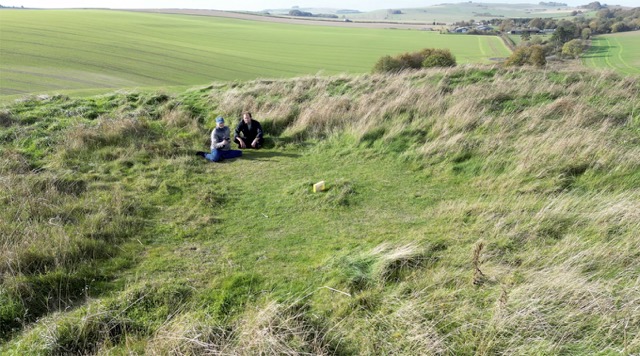
- Towards the light...
- ...passing by a flock of sheep
- The two co-creators contemplating the placement within the beautiful Wiltshire landscape
- The big eye is watching...
- Recording and listening to the surroundings
- Witnessing the yellow light.
Belgium: We start in Essen, close the haven-city of Antwerp and the Dutch border, where we co-create the partial sculptures in a workshop with local people. During these workshops we make some portraits of these early co-creators. The first placements will be done with our results from this workshop, too. Holland: Crossing the border from Belgium, we continue our placements each 48 kilometer heading towards Rotterdam, Utrecht, Amsterdam and Groningen. Since we do not have this culturally and historically rich area on our main routes in W#1 – W#4, our interest of understanding the values of this region is big. In Belgium and Holland we are facing an anthropological approach towards the local people/co-creators. Belgian Anthropologist Mitte Scheldemann will guide, monitor and evaluate the process with us. With her help we define the standards for our scientific approach on our anthology of human values that will follow us around the globe. Germany: Crossing the border to Germany, still following the old routes of the Hansa, it presents itself and its inhabitants in a different glance with every placement we do. Via Hamburg we arrive at the Baltic Sea: Lübeck, Rostock, Greifswald and arriving at the Island of Usedom. Slavic sounding city names remind us of the rich cultural and political exchange in this region ever since. At this place we cross the border to Poland: Placing our sculptural mosaic of WEARTH encaustic wax bricks each 48km along the Baltic Sea coast, we reach the cultural heritage Gdansk. From here it is only a stone’s throw to the Russian exclave Kaliningrad, where we also place some stones with the locals. In Germany, Poland and Russia we are targeting at an artistic outcome of the literary portraits by working together with German, Polish and Russian speaking authors, who give written testimony of the values accounted for in their respective languages. This pilot gives us a better feeling and insight of the bigger picture- of OUR GLOBAL SCULPTURE WEARTH. Each placement opens our view for a different perspective, for individual ways of approaching life, for the vast variety of values on our planet. Both routes, Belgium – Holland – Germany and Germany – Poland –Kaliningrad will be followed by our camera team. All the outcome- the scientific essays, the literary portraits, the documentary movie and the photographs will be published to gain as much attention as possible. The attention is the base for all the support we need to make the global sculpture come true. Thanks for all co-creating with us; this trip is WEARTH it!
Contact us for an individual workshop at your place, firm or to co-create with us by other means.

With this placement 4A1B – “TURNER” we created a bridge between the Celtic mound of Silbury Hill (At 39.3 metres (129 ft) high, the hill is the tallest prehistoric man-made mound in Europe and one of the largest in the world; it is similar in volume to contemporary Egyptian pyramids) and our contemporary Land Art project WEARTH, in this case particularly remembering the great English painter Joseph Mallard William Turner.
Silbury Hill is part of the complex of Neolithic monuments around Avebury, which includes the Avebury Ring and West Kennet Long Barrow. Its original purpose is still debated. Several other important Neolithic monuments in Wiltshire, including the large henges at Marden and Stonehenge, may be culturally or functionally related to Avebury and Silbury.
Composed mainly of chalk and clay excavated from the surrounding area, the mound stands 39.3 metres (129 ft) high and covers about 2 hectares (5 acres). The hill was constructed in several stages between c. 2400~2300 BCE and displays immense technical skill and prolonged control over labour and resources. Archaeologists calculate that it took 18 million man-hours, equivalent to 500 men working for 15 years to deposit and shape 248,000 cubic metres (324,000 cu yd) of earth and fill. Euan MacKie asserts that no simple late Neolithic tribal structure as usually imagined could have sustained this and similar projects, and envisages an authoritarian theocratic power elite with broad-ranging control across southern Britain.
The base of the hill is circular and 167 metres (548 ft) in diameter. The summit is flat-topped and 30 metres (98 ft) in diameter. A smaller mound was constructed first, and in a later phase much enlarged. The initial structures at the base of the hill were perfectly circular: surveying reveals that the centre of the flat top and the centre of the cone that describes the hill lie within a metre of one another. There are indications that the top originally had a rounded profile, but this was flattened in the medieval period to provide a base for a building, perhaps with a defensive purpose.
The first clear evidence of construction, dated to around 2400 BCE, consisted of a gravel core with a revetting kerb of stakes and sarsen boulders. Alternate layers of chalk rubble and earth were placed on top of this: the second phase involved heaping further chalk on top of the core, using material excavated from a series of surrounding ditches which were progressively refilled then recut several metres further out. The step surrounding the summit dates from this phase of construction, either as a precaution against slippage, or as the remnants of a spiral path ascending from the base, used to raise materials during construction, and later as a processional route.
Silbury Hill was originally entirely white since it had a chalk (limestone) exterior, and the surrounding ditch may have been regularly filled with water from underground springs.
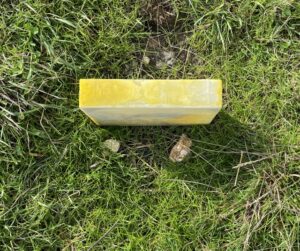
On a hill above the river Wylye is a circle of stones.The body of the brick cuboid casts shadows on other bodies, reducing the light there. Despite its massiveness and unity, this encaustic stone does not do this evenly, as it is variably translucent. The iridescent yellow tones of the bar thus work with light in two ways: partly they reflect it and partly they let it through. The changing play of light refers to the uniqueness of the moment.
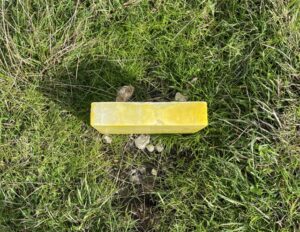
“Our image of children no longer considers them as isolated and egocentric, does not only see them as engaged in action with objects, does not emphasise only the cognitive aspects, does not belittle feelings or what is not logical and does not consider with ambiguity the role of the reflective domain. Instead our image of the child is rich in potential, strong, powerful, competent and, most of all, connected to adults and children.”
Loris Malaguzzi
The Italians believe beauty is a necessary condition for learning. Beauty, in our interpretation, is not a characteristic to just be added. It is a crucial condition. It’s part of our DNA in the construction of the environment so that children and adults can feel at ease and can support each other. Steno Tedeschi
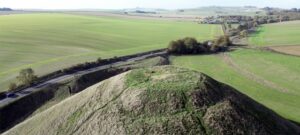
Screenshot
When placing the WEARTH encaustic wax brick (this very yellow wax bar was called TURNER), a strong wind whistled at the top of the artificial Celtic volcano. Two birds of prey hovered above our heads, and we felt at one with heaven and earth. From this small plateau at the top of the mound, you could easily see the gently rolling hills around Avebury. If our ancestors lit a beacon here, it must have been visible from far and wide. It is difficult to imagine what the actual shape of this truncated cone looked like. It was white on the outside, a colour produced by the limestone. In addition, a spiral path wound up the slope from the foot to the top.
The paths that now exist do not have the beautiful shape that was once used to transport building materials and later probably served ritual processions to the top, to enlightenment, to heaven: they tend to lead straight or at a slight incline from the foot to the top. But they go in almost all directions; there is no ‘main road’ leading to the top. It is also not clear whether it was the animals (sheep are ubiquitous in Britain and can be found in all the surrounding pastures) that created these beaten paths, this break in the vegetation. However, one thing is clear: the fireplace at the summit certainly did not come from the peacefully grazing sheep.
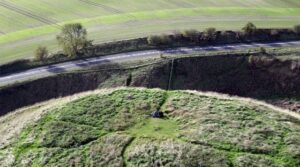
Today we have a rather noisy road (not that it is particularly large, but the loud noises of the passing vehicles seem to be particularly well multiplied and amplified there) that passes at the foot of the hill. When you drive past it on this road, it appears particularly imposing in its size, reminding us that we have achieved what we are, for better or for worse, by working together: Silbury Hill is a flawless symbol of human co-creation. For me, it becomes land art because this enormous effort had no practical use, so it served (possibly ritual) worship, and it seems modelled with a strong connection to the landscape. Yes, this effect extends to the present day. And if we want to add something to this wonderful creation of many people, then it is on this modelled level, and in a temporary and modest way, a spiritual addendum and appreciation more than an intervention. Thus, a new element is added in this appreciation: a view beyond time. Our yellow, our sulphurous colour, our nourishing corn, reminds us of the great painter Turner, but also of the volcanic eruption in Indonesia that led to the many shades of yellow in the English sky, inspired JMW Turner, and may show us that, no matter where we are on the globe, we live in an interdependent terrestrial coexistence. And that exists as long as the earth and we exist.
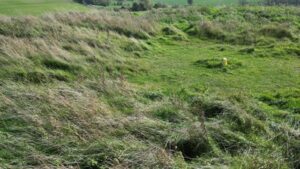
Lying like Goya’s Maja, Stefan looks at the observing eye. The only difference this time is that the observer is above him and not at eye level with the observer in the museum, as in Goya’s painting. Stefan looks to the source and the source to him. The stone TURNER was placed in a horizontal position in the middle of the upper round plateau, exactly as our co-creator lay down in a horizontal position.
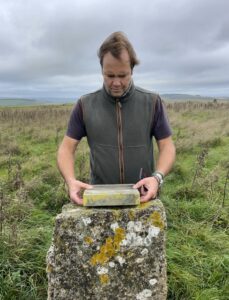
When placing ‘TRUFLE’ on this windy autumn day, Stefan very carefully chooses the direction, position and orientation, whether it should be a portrait variant emphasising the vertical or the horizontal orientation facing the landscape. It took a moment for Stefan to find the right stele within the ‘Celtic’ Land Art circle. The one he chose also had carved marks, the meaning of which probably had something to do with the local selection of the circle’s position within the larger landscape structure of the surrounding area. Ultimately, however, we did not receive a clear answer to this question, so this must remain a more or less educated guess.
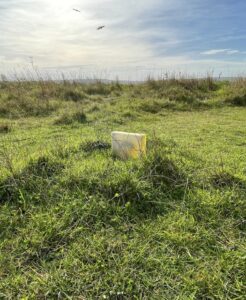
Despite the commitment of our subsidiary projects such as Wearth.Worth, which one might be inclined to see as socially, economically or politically relevant, WEARTH is to be seen as strictly supranational and beyond the scope of day-to-day political dialogue. As those committed to art, we work at the level of human perception, and thus with something that connects us Interior spaces are just as open as the aspects of the individual dimensions or the dimensions associated with them. To use the first dimension as a filter means to see the divine, the true, the source and to live from it. The ultimate achievement in this perception is when the perception of the self merges with the highest or fundamental. In the second dimension, essentially shaped by the day/night experience of our monostellar existence here on Earth, two-dimensional media such as this text, numbers, digits, drawings or even binary classifications such as yin-yang, good-evil, true-false appear. In the third dimension, we encounter our body and all celestial bodies in their creation, being and decay: the union of two beings gives rise to a third being, both in a biological sense and in the nature of poetry. Freemasons already knew that the third dimension is the decisive one when it comes to effectiveness, including spiritual effectiveness, within the framework of our earthly existence. The body casts a shadow, not the other way around.
Do you see the two birds-of-prey hovering above our placement?
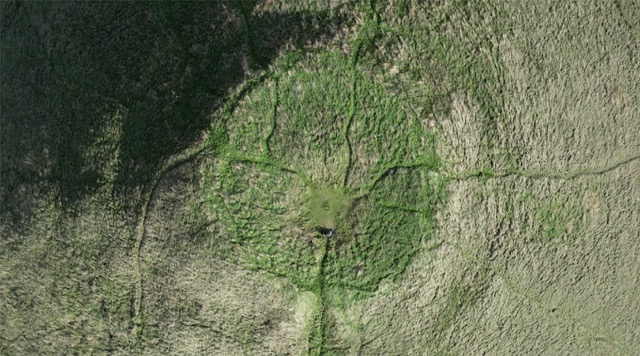
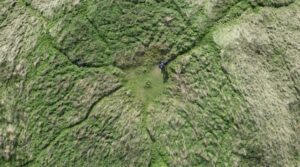
A circle is a shape consisting of all points in a plane that are at a given distance from a given point, the centre.
Using this symbol implies that we focus on everything equal in us, having the same distance to the center or source.
The bottom and the top of Silbury Hill are circles, connected originally with a winding, spiralling road from the plain towards the sky, getting more and more close to the center.
With brick 4A1B, *TURNER* we were co-creating with Stefan L. the first three hexagonal protocol placements on the British Islands. This second one was at Silbury Hill, Avebury, Wiltshire, England.